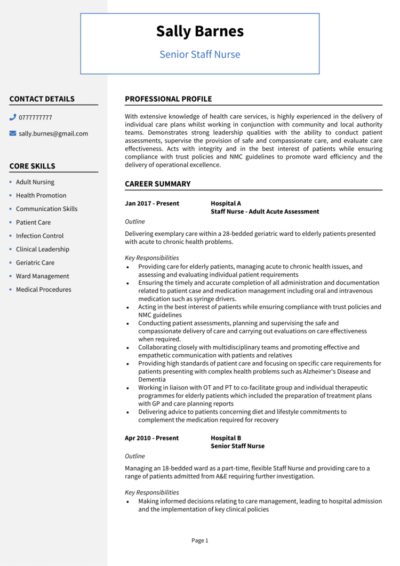Are you ready to prescribe your skills to the perfect job?
As a medical professional, you’re the expert at diagnosing and caring for patients. But before you can scrub in, you’ll need a CV that proves you’re as capable in the job market as you are in the hospital.
This guide, complete with Medical CV examples, will show you how to showcase your clinical experience and passion for patient care to land your next role in medicine.
Senior Nurse CV example
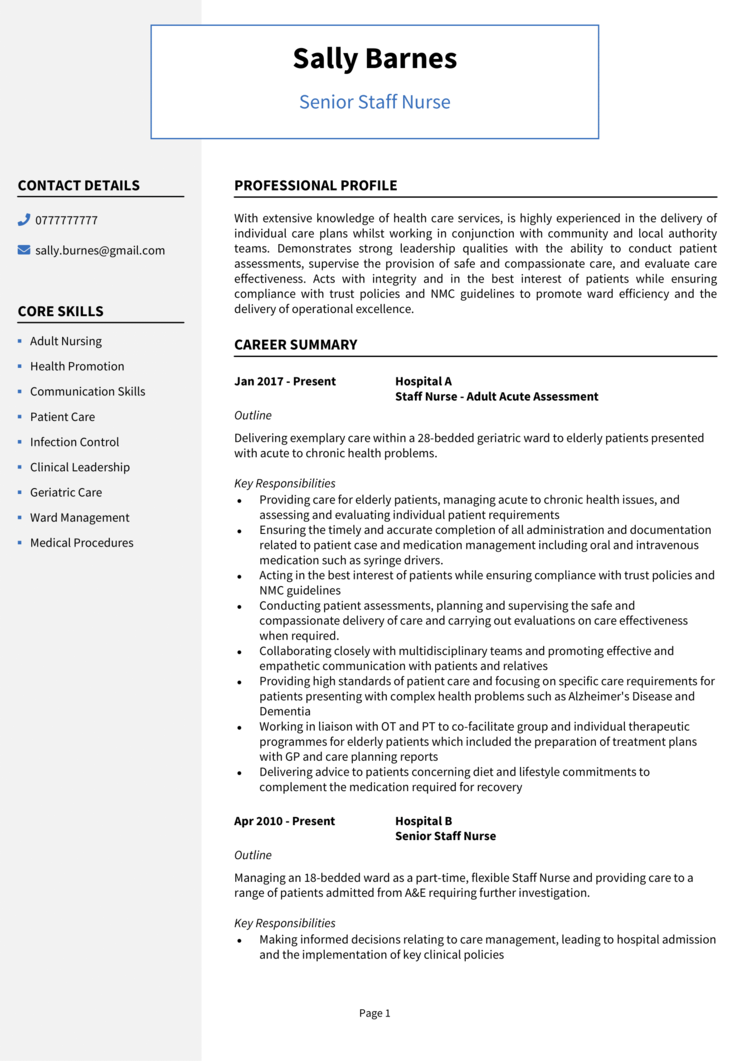
General Practitioner CV example

Dentist CV example

Pharmacist CV example
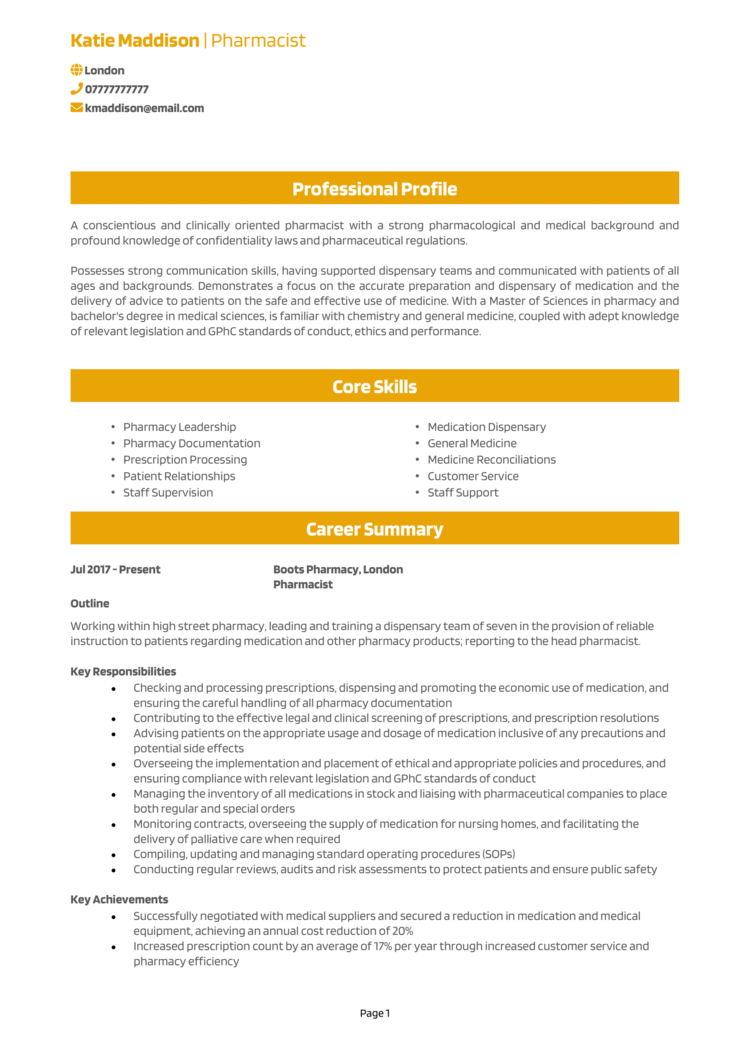
Phlebotomist CV example
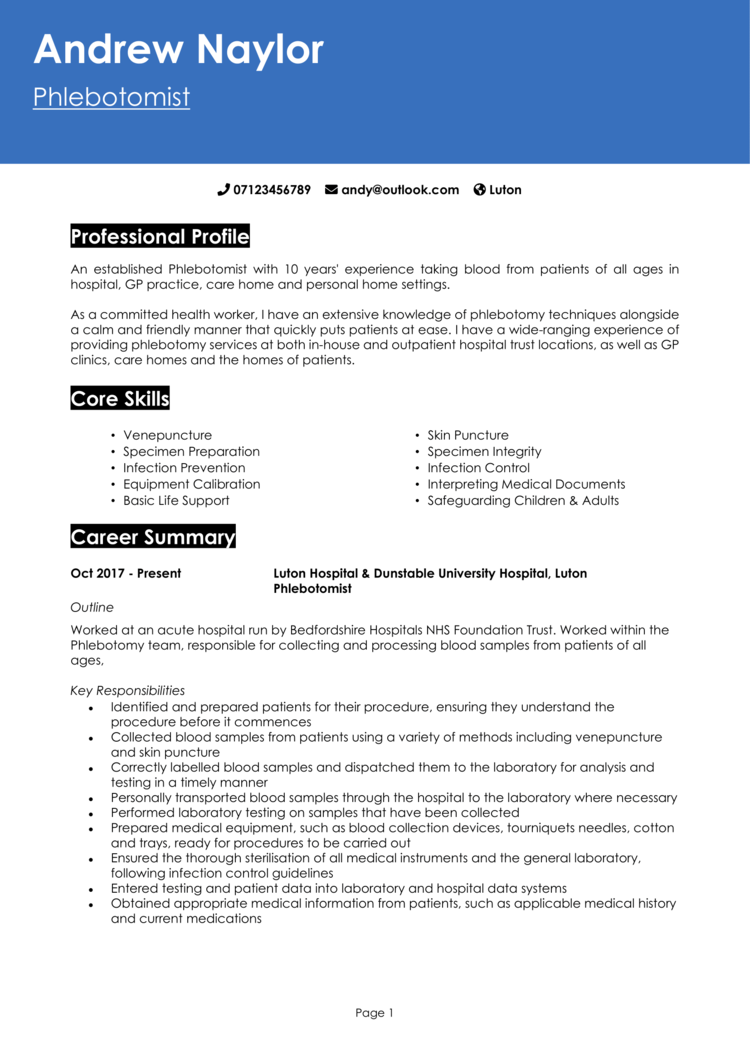
Medical Advisor CV example
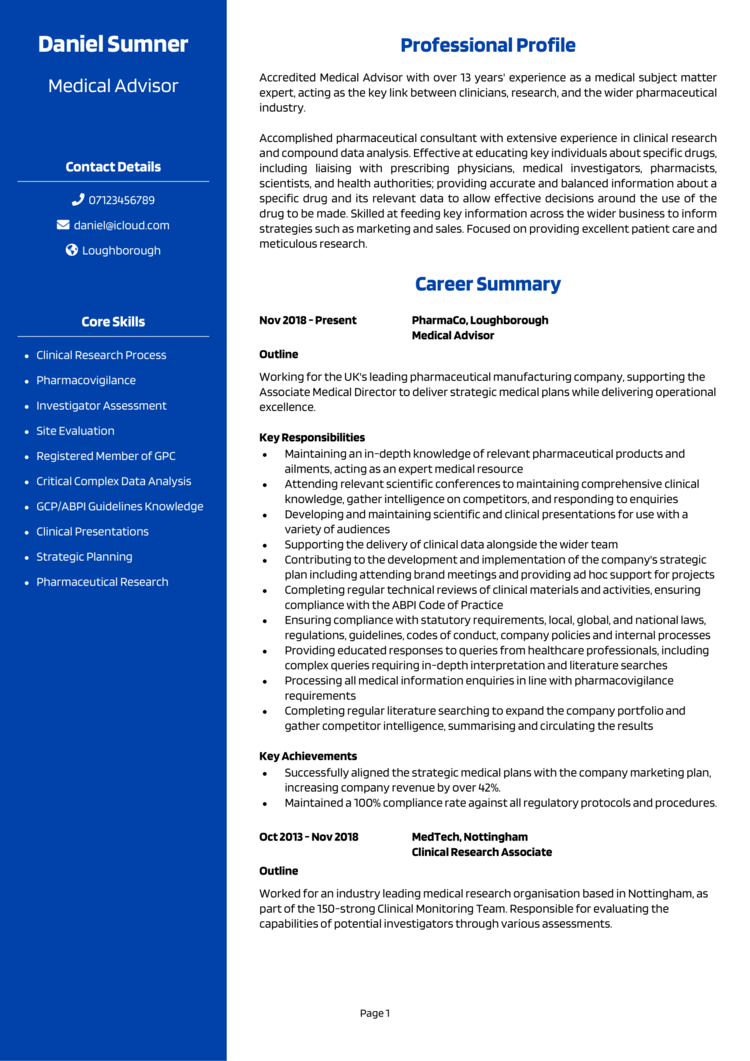
Healthcare Assistant CV example
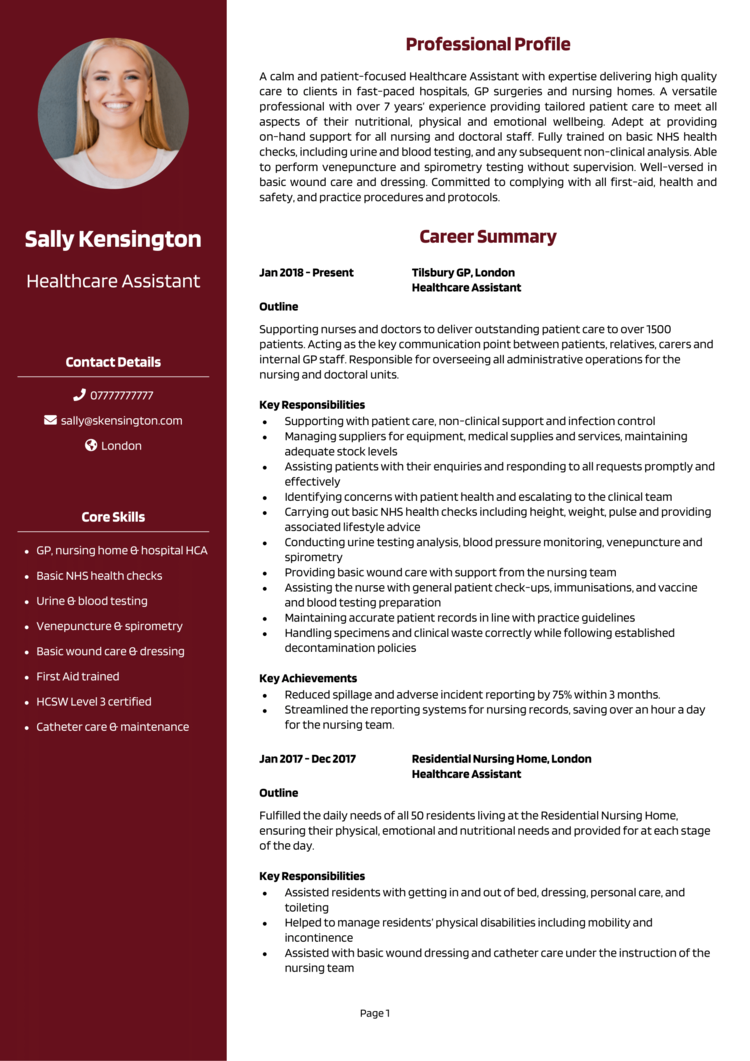
Medical Student CV example
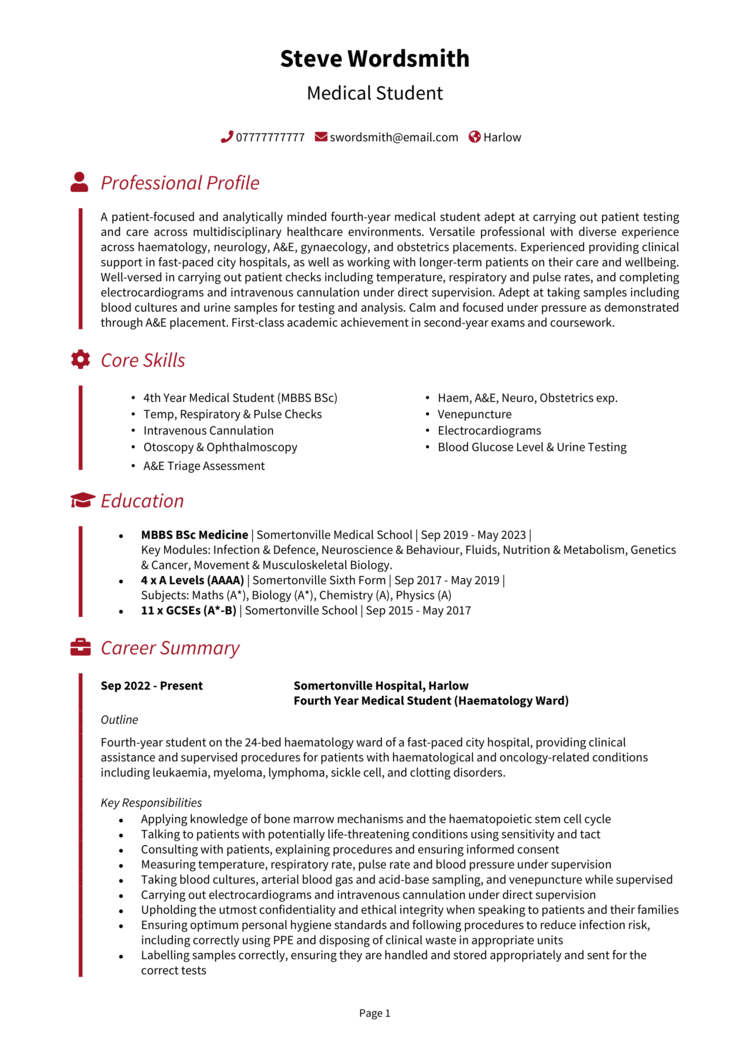
Social Worker CV example

How to write your Medical CV
Learn how to create your own interview-winning Medical CV with this simple step-by-step guide.
Whether you’re a doctor, nurse, or allied health professional, your CV needs to highlight your specialist expertise, dedication to patient care, and ability to thrive in a high-pressure environment.
This guide will help you write your journey in the healthcare field and tailor your CV to suit any medical role you’re pursuing.
How should you structure your Medical CV?


Think of your CV’s structure like a patient chart: organised, easy to read, and with absolutely no room for errors. Recruiters and medical boards want to quickly assess your credentials, clinical experience, and specialisations: don’t make them search for it.
Here’s how to structure your Medical CV:
- Name and contact details – Ensure your name and contact details are easily visible at the top. A photo is optional and depends on the role.
- Profile – Craft a short introduction that showcases your professional background and patient care approach.
- Core skills – List your key abilities in this section, focusing on those that will be most relevant to the job, like diagnostics and treatment planning.
- Work experience – Provide a detailed breakdown of your work history, starting with the most recent job first, honing in on responsibilities and achievements.
- Education – List your qualifications, including degrees and relevant certifications, in reverse chronological order.
- Additional info – Include any additional details, like hobbies and interests or memberships, that highlight your skills or personality.
The correct format for a Medical CV


Formatting your CV is like following a treatment plan – just stick to the basics and avoid unnecessary complications, and it’ll work wonders. Your CV should be easy to read, well-organised, and mistake-free.
Here’s how to format your Medical CV:
- Bullet points – Use brief, sharp bullet points to present your responsibilities and achievements clearly for the recruiter to skim with ease.
- Divide sections – Make use of distinct headings and logical spacing to guide recruiters through your CV.
- Use a clean font – A simple, professional font ensures readability while keeping the layout polished and tidy.
- Keep it the right length – Aim for no more than 2 pages. This gives you space to detail your experience while keeping it concise enough to respect the recruiter’s time.
Medical CV profile


Your CV profile is the first thing recruiters or medical boards will read, so it needs to grab their attention and summarise your clinical expertise, patient care philosophy, and career aspirations.
It’s your CV’s opening diagnosis – get it right, and recruiters will want to see more. Get it wrong, and you’re sending them running for a second opinion.
Medical CV profile examples
Profile 1
Experienced Dentist with eight years of expertise in general and restorative dentistry, focusing on preventative care, cosmetic procedures, and patient education. Skilled in performing root canals, crowns, and teeth whitening treatments, with a commitment to patient comfort and care.
Profile 2
Dedicated Phlebotomist with four years of experience in hospital and laboratory settings, specialising in venipuncture and specimen handling. Skilled in maintaining patient comfort, adhering to strict infection control protocols, and ensuring accurate sample processing.
Profile 3
Compassionate Doctor with over 10 years of experience in general medicine, specialising in diagnosing and managing acute and chronic illnesses. Skilled in patient care, clinical decision-making, and collaborating with multidisciplinary teams to deliver comprehensive treatment plans.
What to include in your Medical CV profile
Here are some tips to make your profile as polished as your best patient care routine:
- Where you’ve worked – Specify the hospitals, clinics, or practices where you’ve gained experience.
- Your top qualifications – Highlight degrees, medical licenses, and specialist training.
- Key skills – Tell the recruiter your biggest strengths like diagnostics, surgical procedures, or patient education.
- Specialist areas – Reference fields such as paediatrics, emergency medicine, or radiology.
- Patient care philosophy – Mention your commitment to improving patient outcomes and wellbeing.
Core skills section


Your core skills section is a quick way to demonstrate your clinical expertise and professional strengths.
For medical professionals, this should highlight a mix of technical skills, specialist knowledge, and patient-focused abilities. Tailor these to the role you’re applying for to ensure maximum impact.
Need help crafting a strong medical CV?
Try our CV builder for structured templates, pre-written content for medical roles, and expert advice to highlight your skills and experience effectively.
Top skills for your Medical CV
- Diagnostics and Assessments – Expertise in evaluating patient symptoms and determining appropriate treatments.
- Surgical Assistance – Assisting in or performing surgical procedures with precision and care.
- Emergency Response – Delivering prompt and effective care in high-pressure situations.
- Patient Education – Communicating medical information clearly to patients and their families.
- Team Collaboration – Working effectively within multidisciplinary teams to ensure optimal patient care.
- Treatment Planning – Developing comprehensive care plans tailored to individual patient needs.
- Medication Management – Prescribing and monitoring medications to ensure efficacy and safety.
- Public Health Awareness – Promoting preventative healthcare and community wellbeing.
- Data Interpretation – Analysing medical test results to guide treatment decisions.
- Regulatory Compliance – Ensuring adherence to healthcare standards and ethical guidelines.
The best way to present work experience


Your work experience section is where you show that you’ve been in the thick of it, whether that’s saving lives in A&E or making rounds with a clipboard in hand.
Demonstrate your clinical capabilities and the impact you’ve made in previous roles. List your roles in reverse chronological order, focusing on key responsibilities and achievements.
And if you’re just starting out, remember: every doctor has to do rotations before becoming a consultant. Highlight internships, volunteer work, or shadowing experiences – they all count.
How should you list jobs on your Medical CV?

- Outline – Provide a brief overview of the organisation, your role, and the type of patients or cases you managed.
- Responsibilities – Highlight tasks like patient assessments, treatment administration, or surgical assistance. Use action verbs like “delivered,” “performed,” or “managed.”
- Achievements – Showcase measurable outcomes, such as reduced patient wait times, improved recovery rates, or successful implementation of new protocols. Always include numbers where possible to add impact.
Example jobs for Medical
Dentist | BrightSmile Clinic
Outline
Provided comprehensive dental care to a wide range of patients, focusing on preventative treatments and restorative procedures. Delivered personalised care to ensure optimal oral health and patient satisfaction.
Responsibilities
- Performed dental examinations, cleanings, and restorative procedures such as fillings and crowns.
- Conducted root canal treatments and tooth extractions with a focus on patient comfort.
- Educated patients on oral hygiene practices to prevent future dental issues.
- Collaborated with dental hygienists and technicians to ensure seamless care delivery.
- Maintained detailed patient records and ensured compliance with health and safety standards.
Achievements
- Increased patient retention by 20 percent through consistent follow-up and care.
- Reduced treatment times by 15 percent by streamlining procedural workflows.
- Recognised by patients for providing a comfortable and stress-free dental experience.
Phlebotomist | Carepath Diagnostics
Outline
Performed venipuncture and specimen collection in a fast-paced laboratory environment, ensuring accurate and timely sample handling. Focused on patient comfort and maintaining strict safety standards.
Responsibilities
- Collected blood samples from patients of all ages using venipuncture and capillary techniques.
- Prepared and labelled specimens for transport to the laboratory, ensuring accurate data entry.
- Followed strict infection control and safety protocols to maintain a sterile environment.
- Provided clear explanations to patients to reduce anxiety during blood collection.
- Collaborated with healthcare providers to ensure timely delivery of test results.
Achievements
- Achieved a 98 percent success rate in first-attempt venipuncture.
- Reduced patient wait times by 20 percent through efficient workflow management.
- Received commendation from supervisors for maintaining exceptional accuracy in sample handling.
Doctor | WellHealth Medical Practice
Outline
Provided holistic care to a diverse patient population in a busy general practice, focusing on acute and chronic condition management. Delivered patient education and preventative care to improve long-term health outcomes.
Responsibilities
- Diagnosed and treated a variety of medical conditions, including hypertension, diabetes, and respiratory infections.
- Performed physical examinations and ordered diagnostic tests to guide treatment plans.
- Prescribed medications and monitored treatment progress to ensure efficacy.
- Referred patients to specialists when necessary and coordinated multidisciplinary care.
- Maintained comprehensive patient records and ensured compliance with regulatory standards.
Achievements
- Improved patient satisfaction scores by 15 percent through personalised treatment plans.
- Reduced hospital referrals by 20 percent through effective in-house management of chronic conditions.
- Recognised for achieving a 98 percent adherence rate to preventative care guidelines.
Education section


The education section is critical for medical professionals. Include your degrees, medical school, and any postgraduate training or certifications: they all underline your specialist skills.
List your qualifications in reverse chronological order, starting with the most recent. For recent graduates, focus on coursework, clinical rotations, and relevant academic achievements.
Key qualifications for a Medical CV
- Bachelor of Medicine, Bachelor of Surgery (MBBS) – The primary qualification for practising medicine.
- Membership of the Royal Colleges of Physicians (MRCP) – Certification in internal medicine for advanced roles.
- Advanced Trauma Life Support (ATLS) – Certification for managing critical trauma patients.
- Diploma in Tropical Medicine and Hygiene (DTM&H) – Specialist training for working in global health settings.
- Fellowship of the Royal College of Surgeons (FRCS) – Advanced surgical training and certification.


